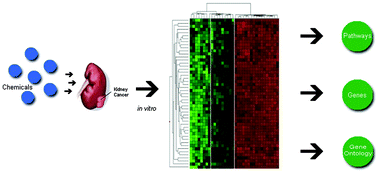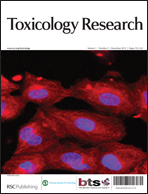Detection of genotoxic and non-genotoxic renal carcinogens in vitro in NRK-52E cells using a transcriptomics approach
Abstract
There is a need to develop quick, cheap, sensitive and specific methods to detect the carcinogenic potential of chemicals. Currently there is no in vitro model system for reliable detection of non-genotoxic carcinogens (NGTX) and current tests for detection of genotoxic carcinogens (GTX) can have low specificity. A transcriptomics approach holds promise and a few studies have utilised this technique. However, the majority of these studies have examined liver carcinogens with little work on renal carcinogens which may act via renal-specific NGTX mechanisms. In this study the normal rat renal cell line (NRK-52E) was exposed to sub-toxic concentrations of selected rat renal carcinogens and non-carcinogens (NC) for 6 h, 24 h and 72 h. Renal carcinogens were classified based on their presumed mode of action into GTX and NGTX classes. A whole-genome transcriptomics approach was used to determined genes and pathways as potential signatures for GTX, NGTX and those common to both carcinogenic events in vitro. For some of the GTX compounds an S9 drug metabolising system was included to aid pro-carcinogen activation. Only three genes were commonly deregulated after carcinogen (GTX + NGTX) exposure, one Mdm2 with a detection rate of 67%, and p21 and Cd55 with a detection rate of 56%. However, examination of enriched pathways showed that 3 out of 4 NGTX carcinogens and 4 out of 5 GTX carcinogens were related to known pathways involved in carcinogenesis giving a detection rate of 78%. In contrast, none of the NC chemicals induced any of the above genes or well-established carcinogenic pathways. Additionally, five genes (Lingo1, Hmox1, Ssu72, Lyrm and Usp9x) were commonly altered with 3 out of 4 NGTX carcinogens but not with NC or GTX carcinogens. However, there was no clear separation of GTX and NGTX carcinogens using pathway analysis with several pathways being common to both classes. The findings presented here indicate that the NRK-52E cell line has the potential to detect carcinogenic chemicals, although a much larger number of chemicals need to be used to confirm these findings.


 Please wait while we load your content...
Please wait while we load your content...